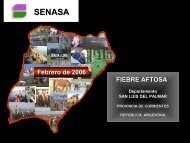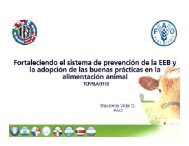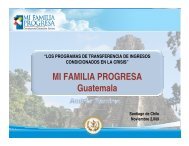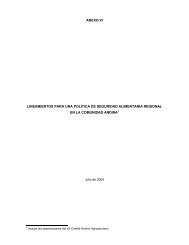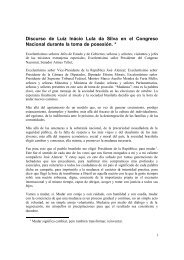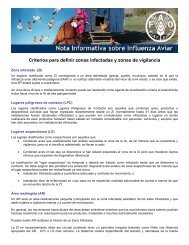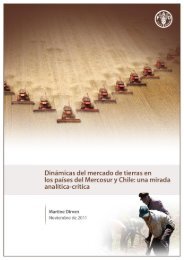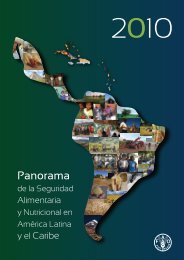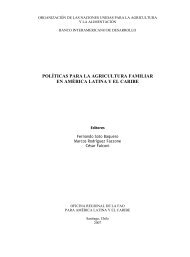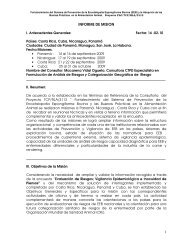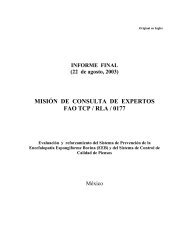Documento completo en formato pdf (483Kb) - Cepal
Documento completo en formato pdf (483Kb) - Cepal
Documento completo en formato pdf (483Kb) - Cepal
- No tags were found...
You also want an ePaper? Increase the reach of your titles
YUMPU automatically turns print PDFs into web optimized ePapers that Google loves.
CEPAL - Serie Políticas sociales N o 156Pueblos indíg<strong>en</strong>as y programas de transfer<strong>en</strong>cias con corresponsabilidad…Layton, H.M. y Patrinos, Harry (2006) “Estimating the number of indig<strong>en</strong>ous peoples in Latin America” <strong>en</strong>Hall y Patrinos (eds), Op. cit.León, Arturo (2008), Progresos <strong>en</strong> la Reducción de la Pobreza Extrema <strong>en</strong> América Latina. Dim<strong>en</strong>siones yPolíticas para el Análisis de la Primera Meta del Mil<strong>en</strong>io. CEPAL/AECID, Santiago de Chile, Septiembredel 2008.Lloyd-Sherlock, Peter (2008) “Doing a Bit more for the Poor? Social Assistance in Latin America” <strong>en</strong> Journalof Social Policy, Vol. 34, No. 4: 621 – 639.Madariaga, Aldo (2008) “Cuándo y cómo condicionar? Mitos y realidades de los PTC <strong>en</strong> América Latina”,División de Desarrollo Social, CEPAL, Santiago de Chile, inédito.Madrid, Jorge y Hernandez, Artinelio C. (2009) “Las políticas sociales implem<strong>en</strong>tadas por el Estadopanameño <strong>en</strong> la reducción de la pobreza indíg<strong>en</strong>a (1995 – 2005): el caso de la comarca Kuna Yala”,División de Desarrollo Social, CEPAL, Santiago de Chile, inédito.Martínez, Rodrigo y Fernández, Andrés (2006) “Modelo de análisis del impacto social y económico de ladesnutrición infantil <strong>en</strong> América Latina”, Serie Manuales, No. 52, División de Desarrollo Social,Comisión Económica para América Latina y el Caribe, Santiago, Chile: Naciones Unidas.Mesa-Lago, Carmelo (2008) “Social insurance (p<strong>en</strong>sions and health), labour markets and coverage in LatinAmerica”, Social Policy and Developm<strong>en</strong>t, Programme Paper No. 36, United Nations Research Institutefor Social Developm<strong>en</strong>t.Norton, Andrew; Gacitúa-Marió, Estanislao; Georgieva, Sophia V. (2009) “Introduction: Social Policy,Citiz<strong>en</strong>ship, and the Realization of Rights”, Gacitúa-Marió, Norton y Georgieva (Eds) Building equalityand opportunity through social guarantees. Washington, USA: The International Bank for Reconstructionand Developm<strong>en</strong>t/ The World Bank.Núñez, Jairo y Cuesta, Laura (2006) “Colombia: Programa Familias <strong>en</strong> Acción”, <strong>en</strong> Coh<strong>en</strong> y Franco, op.cit.Nyamu-Musembi, Celestine y Cornwall, Andrea (2004) “What is the “rights-based approach” all about?Perspectives from international developm<strong>en</strong>t ag<strong>en</strong>cies”, IDS Working Paper 234, Institute forDevelopm<strong>en</strong>t Studies, Brighton, UK: IDS.Partridge and Uquillas (1996) Including the excluded: Ethnodevelopm<strong>en</strong>t in Latin America. World Bank –Latin American and the Caribbean Technical Departm<strong>en</strong>t. Environm<strong>en</strong>t Unit. [En línea].Patrinos, Harry Anthony, y Skoufias, Emmanuel (2007) Economic Opportunities for Indig<strong>en</strong>ous Peoples inLatin America, Confer<strong>en</strong>ce Edition, Washington, USA: The World Bank.Plant, Roger (1998a) “Pobreza y Desarrollo Indíg<strong>en</strong>a: Algunas Reflexiones”, Banco Interamericano delDesarrollo. [En línea] http://www.bid.org.(1998b) “Indig<strong>en</strong>ous Peoples and Poverty Reduction: A Case Study of Guatemala”, Indig<strong>en</strong>ous Peoples andCommunity Developm<strong>en</strong>t Unit, Inter-American Developm<strong>en</strong>t Bank, Sustainable Developm<strong>en</strong>t Departm<strong>en</strong>t.Quesnel, André (2006) “Dinámicas demo-sociales de la población indíg<strong>en</strong>a y afrodesc<strong>en</strong>di<strong>en</strong>te <strong>en</strong> América Latina”<strong>en</strong> Seminario Internacional Pueblos Indíg<strong>en</strong>as y Afrodesc<strong>en</strong>di<strong>en</strong>tes de América Latina y el Caribe, Op. cit.Ramírez, Alejandro (2006) “Mexico” <strong>en</strong> Hall y Patrinos, op.cit.Rappaport, Joanne (2005) Intercultural Utopias. Public Intellectuals, Cultural Experim<strong>en</strong>tation and EthnicPluralism in Colombia. Durham and London, UK: Duke University Press.R<strong>en</strong>shaw, Jonathan (2001) “Social Investm<strong>en</strong>t Funds and Indig<strong>en</strong>ous Peoples”, Washington, D.C.: Inter-American Developm<strong>en</strong>t Bank.R<strong>en</strong>shaw, John y Natalia Wray (2004) “Indicadores de Pobreza Indíg<strong>en</strong>a”, Washington, D.C.: BancoInteramericano del Desarrollo.R<strong>en</strong>tería, Carolina (2009) “Avances y retos de la política social <strong>en</strong> Colombia”, Bogotá, Colombia:Departam<strong>en</strong>to Nacional de Planeación (DNP).Salomon, Margot (Ed) (2005) Economic, Social and Cultural Rights: A Guide for Minorities and Indig<strong>en</strong>ousPeoples, London, UK: Minority Rights Group International, ISBN 1 904584 25 X.Salomon, Margot y Arjun S<strong>en</strong>gupta (2003) The Right to Developm<strong>en</strong>t: Obligations of States and the Rights ofMinorities and Indig<strong>en</strong>ous Peoples, London, UK: Minority Rights Group International.Sawyer, Suzana y Gomez, Edmund Ter<strong>en</strong>ce (2008) “Transnational Governm<strong>en</strong>tality and Resource Extraction.Indig<strong>en</strong>ous Peoples, Multinational Corporations, Multilateral Institutions and the State”, Id<strong>en</strong>tities,Conflict and Cohesion, Programme Paper No. 13, Ginebra, Suiza: United Nations Research Institute forSocial Developm<strong>en</strong>t.52



